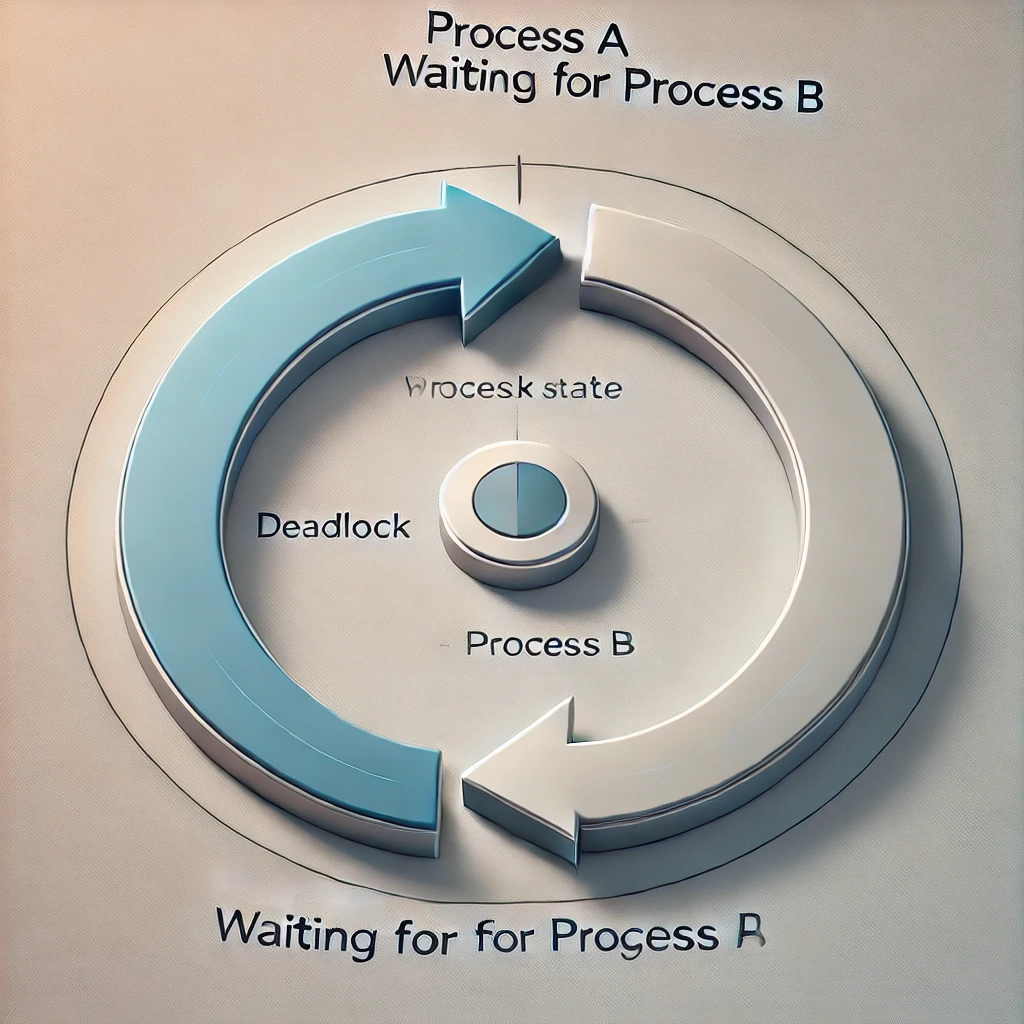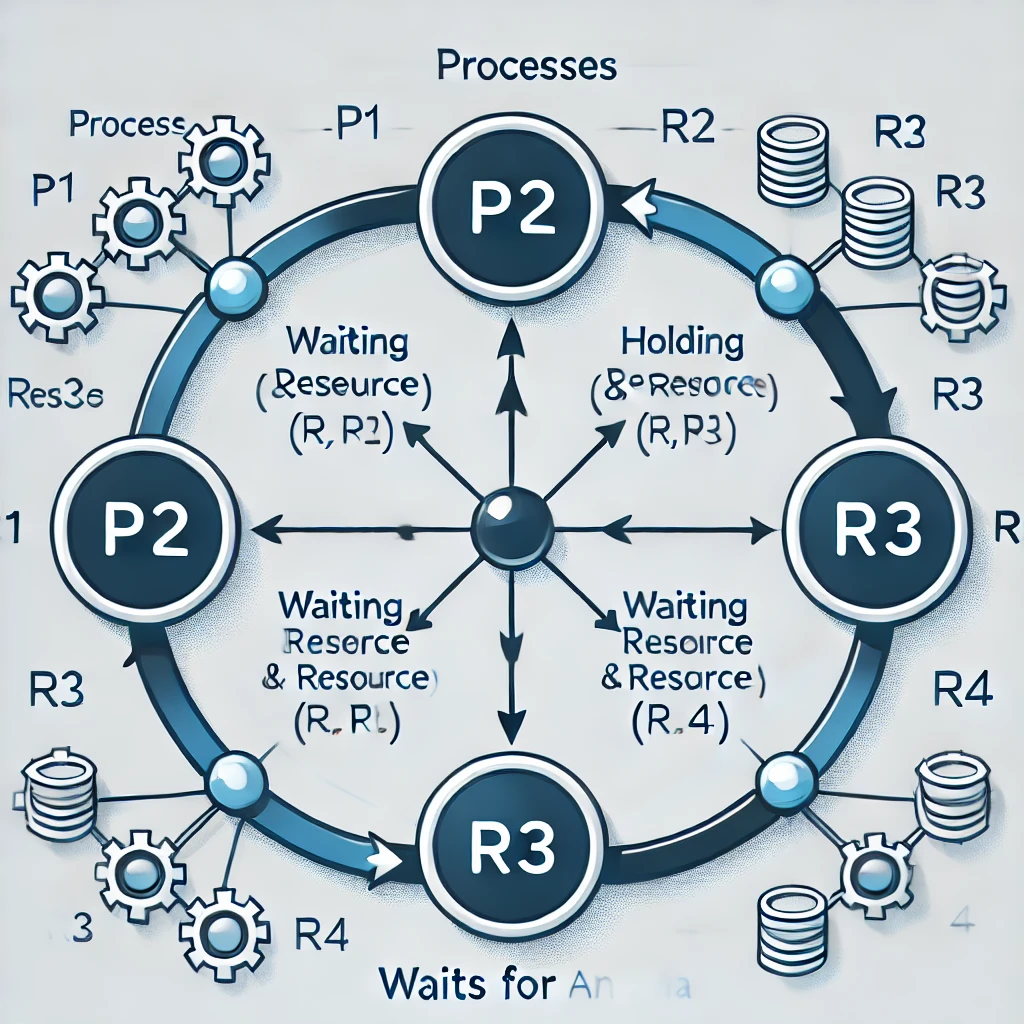Last Updated:
Deadlocks in Operating Systems: Causes, Prevention, and Solutions
Introduction
Deadlocks are one of the most critical challenges in operating system management. They occur when two or more processes become indefinitely stuck, each waiting for resources held by the other(s). These situations can freeze system functionality, leading to wasted resources, decreased performance, and frustrated users. As modern systems rely heavily on multitasking and resource sharing, understanding and managing deadlocks is crucial to ensure efficiency, reliability, and stability.
This article dives deep into the intricacies of deadlocks in operating systems, exploring their causes, necessary conditions, detection, resolution strategies, and real-world examples. Whether you’re a software engineer or a student, this guide will enhance your understanding and problem-solving skills related to deadlocks.

A conceptual diagram illustrating two processes in a circular wait state, unable to proceed.
What is a Deadlock?
A deadlock occurs in an operating system when two or more processes cannot proceed because each is waiting for a resource held by another process. This creates a situation where none of the involved processes can complete, leading to a system freeze. Deadlocks are especially problematic in environments where multiple users or applications share limited resources, such as CPUs, printers, or memory.
To better understand this concept, imagine two cars meeting on a narrow bridge, each refusing to reverse. Both cars remain stationary because each driver waits for the other to back up. Similarly, in computing, processes in a deadlock are "stuck" indefinitely.
Key Characteristics of Deadlocks:
- Mutual Exclusion: At least one resource is held in a non-sharable mode, meaning only one process can use it at a time (e.g., printers).
- Hold and Wait: Processes already holding resources may request additional resources held by other processes.
- No Preemption: Resources cannot be forcibly taken from processes; they must be released voluntarily.
- Circular Wait: A closed chain of processes exists, where each process waits for a resource held by the next in the chain.
These four conditions must all be present for a deadlock to occur. Breaking even one of these conditions can prevent deadlocks from happening.

A diagram visually explaining the four conditions of deadlock with real-world examples.
Causes of Deadlocks
Deadlocks often arise due to improper resource allocation, poor synchronization, or conflicts between processes. Understanding the common causes can help in designing better systems that minimize the likelihood of such issues.
- Resource Competition: Limited resources, such as printers, files, or CPU time, create competition among processes. If multiple processes simultaneously request the same resource, a deadlock may occur.
- Improper Synchronization: Processes must be synchronized to access shared resources. For example, failure to lock a shared file properly can result in multiple processes attempting to write to it simultaneously, leading to conflicts and potential deadlocks.
- Circular Dependency: In some cases, processes depend on each other in a circular chain, with each process holding a resource that another process needs.
- Resource Allocation Mistakes: Poor planning in how resources are allocated and released, such as allowing processes to hold resources indefinitely, can increase the risk of deadlocks.
Examples of Deadlock Situations:
- File Access: Two processes access a file for writing. Each process locks a different part of the file but waits indefinitely for the other to release its lock.
- Database Transactions: Two transactions wait on locks held by each other, preventing either from proceeding.
- Printer and Scanner Example: Process A holds the printer and waits for the scanner, while Process B holds the scanner and waits for the printer.

A network graph illustrating a circular dependency among processes and resources.
Prevention of Deadlocks
Preventing deadlocks involves designing the system to avoid at least one of the necessary conditions for deadlocks. This requires careful resource management, process scheduling, and adherence to system protocols.
Strategies for Prevention:
- Eliminate Mutual Exclusion: Make resources shareable wherever possible. For example, read-only files can be shared by multiple processes without conflict.
- Avoid Hold and Wait: Require processes to request all required resources at once, preventing situations where processes hold some resources and wait for others.
- Preempt Resources: Allow the operating system to forcibly take resources from processes, reallocating them as needed.
- Avoid Circular Wait: Assign a priority or ordering to resources and require processes to request them in this order, breaking the circular dependency.
Suggested Image: A flowchart showing how to enforce resource allocation ordering to avoid circular waits.
Detection and Resolution of Deadlocks
Detection:
- The operating system periodically analyzes the resource allocation graph to check for cycles. If a cycle exists, a deadlock is present.
- Deadlock detection algorithms like the Wait-For Graph help identify problematic processes and resources.
Detection is computationally expensive and may not always be feasible in real-time systems. However, periodic checks in batch processing systems are effective.
Suggested Image: Diagram showing how the resource allocation graph detects cycles.
Resolution:
- Terminate Processes: Forcefully abort one or more processes involved in the deadlock to free up resources.
- Resource Preemption: Temporarily take resources from processes to resolve the deadlock and reallocate them to waiting processes.
- Process Rollback: Revert processes to an earlier safe state and resume execution, ensuring no deadlocks occur during retry.
Suggested Image: Visual representation of resolving deadlocks by terminating or rolling back processes.
Advanced Solutions to Deadlocks
In addition to prevention and detection, advanced techniques focus on minimizing deadlock risks through proactive system design.
- Banker’s Algorithm: Ensures the system remains in a safe state by granting resource requests only when it guarantees that future requests can also be satisfied.
- Dynamic Prioritization: Assign dynamic priorities to processes to preempt resources when higher-priority processes need them.
- Timeout Mechanisms: Automatically release resources if a process holds them for too long without progress.
Suggested Image: Flowchart demonstrating the Banker’s Algorithm in a hypothetical scenario.
Conclusion
Deadlocks are complex yet essential to address in operating systems. By understanding their characteristics, causes, and solutions, system designers can create robust and efficient systems. Prevention strategies like avoiding circular waits, advanced algorithms such as Banker’s Algorithm, and timely detection mechanisms can significantly reduce the risk of deadlocks.
With a thorough grasp of deadlocks, you can ensure smoother process execution, optimal resource utilization, and enhanced system performance. Regular monitoring and a proactive approach to system design are the keys to achieving a deadlock-free environment.
Suggested Image: Infographic summarizing all key strategies and solutions to handle deadlocks.